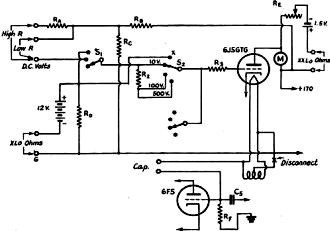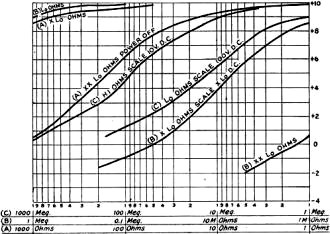June 1944 QST
 Table
of Contents Table
of Contents
Wax nostalgic about and learn from the history of early electronics. See articles
from
QST, published December 1915 - present (visit ARRL
for info). All copyrights hereby acknowledged.
|
Prior to the advent of FET-input multimeters,
obtaining a very high input impedance meter required the use of a vacuum tube circuit
that used a buffer stage to isolate the measured signal from the loading effects
of the meter movement. As most people reading this article already know, the voltage
value indicated by a non-buffered meter can be greatly affected by the meter's loading
of the device under test (DUT) if the meter's impedance is not many times greater
than the DUT's impedance. The voltmeter is used in parallel with the circuit under
test, so for example if the impedance of the DUT is 100 kΩ and the meter's
impedance is also 100 kΩ, the meter will display a value as if the DUT itself
had only a 50 kΩ impedance, which represents a huge error. The problem was
that VTVMs were relatively expensive and beyond the budget of most amateurs. This
article from the June 1944 edition of QST presents a simple vacuum tube voltmeter
VTVM project that allows the user to measure both resistance and capacitance. Nowadays
you can buy a nice quality equivalent with a digital readout for $50 from
Craftsman, or dedicated
LCR meter for about $35..
Extending the Usefulness of a Versatile Instrument
By A. D. Mayo Jr., W4CBD
Few garden-variety hams have either the equipment or the inclination to construct
elaborate measuring apparatus for checking either condenser capacity or high values
of leakage resistance. This article describes a simple and effective way of making
such checks by the reactance method, requiring only an all-purpose v.t.v.m. as a
non-loading voltmeter.
Almost any a.c, vacuum-tube voltmeter can be used to indicate the approximate
capacities of small condensers without requiring the addition of extra parts. All
that is necessary is to apply the filament-supply voltage to the input terminals
of the meter, in series with the condenser, and note the resulting voltmeter reading.
The voltmeter can be calibrated in micromicrofarads and a separate graph prepared
to make it direct-reading for this use.

Fig. 1 - Changes in wiring required to convert the author's
v.t.v.m, (originally described in November, 1943. QST) into a wide-range instrument
for measuring capacity and resistance.
RA - 90 megohms. RB -1 megohm.
RC - 700,000 ohms. RD - 10,000 ohms. RE
- 200-ohm variable. RF - 3 megohms.

Fig. 2 - Typical resistance calibration curves for the v.t.v.m.

Front view of the v.t.v.m. described in the November issue of
QST, as modified with pin jacks added on the panel for making connections for resistance
and capacitance measurements.

Fig. 3 - Calibrating resistors for extending the range of
the v.t.v.m. are constructed by making pencil marks on an insulating strip, as described
in the text.
This method of checking capacity is similar to that described on page 407 of
the 1944 edition of the ARRL Handbook, which shows how an ordinary 1000-ohms-per-volt
a.c. meter can be used to check capacities down to 0.001 μfd. The principle is
similar to that of the d.c. ohmmeter, except that impedance is measured instead
of resistance. The limitation in the use of this method with an ordinary voltmeter
lies in the fact that an external source of a.c. is required, as well as a resistor
or two and some terminals. Nor does the capacity range extend quite low enough to
check small mica condensers. A vacuum-tube voltmeter using a voltmeter tube on extended
leads overcomes these objections, since a.c, voltage is available at the tube from
the filament supply. With the very high input resistance of the v.t.v.m., the capacity
range covered can be extended down to 50 μμfd. or less. The only leads necessary
are one to the probe tip and one to the ungrounded side of the filament.
When using a 3-megohm input resistor on the probe tube and a filament voltage
in the neighborhood of 6 volts r.m.s., capacities of from 50 μμfd. to 0.002 μd.
will give an indication on the 10-volt scale. The filament voltage will divide between
the input resistance of the meter and the reactance of the unknown condenser. The
internal resistance of the small condenser does not affect the reading unless the
condenser has high leakage or is otherwise defective.
The reactance of a 50-μμfd. condenser at 60 cycles is about 32 megohms.
When this reactance is placed in series with the filament supply and the voltmeter
input terminals, about one-tenth of the supply voltage will appear across the meter.
Practical Application
The homemade v.t.v.m. described in the November, 1943, issue of QST1
has been used in this manner for a rough check of small capacities, and it has turned
out to be a very handy tool.
The changes required in the original circuit may be noted by comparing the diagram
of Fig. 1 with that shown in the November article. To use the meter for this
purpose it was necessary to change the ground connection from the center-tap of
the filament to one side, as shown in the circuit diagram. The voltage at the end
of the tube prod was 5.7 volts r.m.s., which gave a reading of 8 volts peak on the
meter scale. A separate calibration curve was made for capacity against voltage
by taking readings on several condensers which were known to be close to marked
capacity.
In testing a handful of new and junk-box condensers we noted some surprising
readings. Out of about a dozen new mica postage-stamp condensers tested there was
one which showed no capacity at all and another which read so high it was tested
for d.c. resistance and found to have 10 megohms leakage resistance. Any attempt
to use either of these condensers at very high frequencies would probably have led
to a long headache before the trouble could have been found. On the other hand,
one very old condenser of about 1925 vintage, of the type having mica and brass
strips clamped together without any molded Bakelite covering, tested 0.001 μfd.
as marked and did not show any abnormal leakage.
Resistance Measurement
It is apparent that, in order to check a condenser thoroughly, it should be tested
for leakage resistance as well as capacity. The v.t.v.m. also lends itself very
well to conversion into an ohm-meter for reading extremely high values of resistance.
For this purpose the d.c. plate supply is applied to the d.c. voltmeter section
through the unknown resistor in much the same manner as that previously described
for measuring capacity with the a.c. section.
The internal plate-supply voltage of the instrument runs 170 volts above ground.
Of this, 100 volts is tapped off on a voltage divider and applied to the 100-volt
input terminals in series with the resistance to be measured. This scale reads from
1 megohm to 100 megohms and is called the LO-OHM scale. To read higher values of
resistance the 100-volt supply is applied to the 100-volt scale through the unknown
resistor, with an additional resistor of 90 megohms added in series to limit the
maximum voltage applied across the meter input to 10 volts. This scale is labeled
HI-OHMS and it reads from 1 megohm to 1000 megohms.
The HI- and LO-OHM scales worked so well that two additional ones were added
(XLO and XXLO in Fig. 2). The XLO scale is obtained in a manner similar to
that used in the higher resistance ranges, but the input resistance of the meter
had to be reduced by connecting in an additional switch point, shunted with a 12,000-ohm
resistor, as shown in Fig. 1. Since some current was required to operate this
section, a battery was added as the easiest way out. The XXLO scale is made up by
using the milliammeter in a regular ohmmeter circuit with another 1 1/2-volt battery.
It is important that the power be turned off in the meter before using the latter
range, since the meter is in the "B"+ side and is above ground by about 170 volts.
Finally, a terminal was added to the panel to supply one side of the filament voltage.
In using the 1000-megohm range it is important to keep down leakage in the test
prod leads if they are used. The leakage through many insulators will be less than
1000 megohms. Newsprint paper on a damp day will show a reading if the prods are
pressed on it a couple of inches apart. It is best to use a couple of bare wires
pushed in the HI-OHM terminals with the condenser connected to them as close to
the terminals as possible.
Calibration
It turned out to be fairly easy to calibrate the meter at the high ranges. Perhaps
the accuracy of the method used is less than that obtained on the best commercial
bridges, but it is sufficient for our purpose.
In constructing the calibrating resistors, a piece of fiber was drilled with
three holes in a row and machine screws and washers put in the holes, as shown in
Fig. 3. Pencil lines were drawn from under the washers on to the next screw,
making a pair of 1920-model pencil grid leaks in series. A 10-megohm resistor was
obtained and one of the grid-leak sections adjusted to the same resistance as measured
by the meter scale. Then the other grid-leak section was adjusted to the same resistance.
Since the total resistance of both grid-leak sections is 20 megohms, the meter deflection
for 20 megohms was recorded. Then each section was made 20 megohms, making a total
of 40 megohms. Thus, by doubling resistance each time, the calibration was carried
on up to 1200 megohms.
The resistances were adjusted by marking on a little pencil lead or erasing a
little of it until the resistance was correct. The meter was calibrated at the lower
ranges by plotting points from resistors which were measured by another ohmmeter
of good accuracy.
The original meter as shown in November QST did not have a case, but after its
conversion to read ohms and whatnot it was mounted in a wooden case and some additional
terminals put on the panel, as shown in the photograph. It was a case of something
that started out to be a voltmeter and ended up being a meter to read nearly everything
else as well.
For something that was born on the kitchen table from parts out of the junk box,
this thing turned out to be a good little instrument.
1: Mayo. "A V.T. Voltmeter for A.C. and D.C .,"
QST, November. 1943. p.
36.
Posted November 5, 2020
(updated from original post on 9/27/2012)
|













